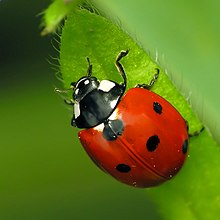Coccinella septempunctata
| Coccinella septempunctata | |
|---|---|
 |
|
| Scientific classification | |
| Kingdom: | Animalia |
| Phylum: | Arthropoda |
| Class: | Insecta |
| Order: | Coleoptera |
| Family: | Coccinellidae |
| Genus: | Coccinella |
| Species: | C. septempunctata |
| Binomial name | |
|
Coccinella septempunctata (Linnaeus, 1758) |
|
Coccinella septempunctata, the seven-spot ladybird (or, in North America, seven-spotted ladybug or "C-7"), is the most common ladybird in Europe. Its elytra are of a red colour, but punctuated with three black spots each, with one further spot being spread over the junction of the two, making a total of seven spots, from which the species derives both its common and scientific names (from the Latin = "seven" and = "spot").
C. septempunctata has a broad ecological range, generally living where there are aphids for it to eat. Both the adults and the larvae are voracious predators of aphids, and because of this, C. septempunctata has been repeatedly introduced to North America as a biological control agent to reduce aphid numbers, and is now established in North America, and has been subsequently designated the official state insect of five different states (Delaware, Massachusetts, New Hampshire, Ohio, and Tennessee).
In the United Kingdom, there are fears that the seven-spot ladybird is being outcompeted for food by the harlequin ladybird. Conversely, in North America, this species has outcompeted many native species, including other Coccinella. Massive swarms of C. punctata took place in the drought summer of 1976 in the UK. It used to be a common on the island of Malta, but over the years it has declined in numbers.
...
Wikipedia
